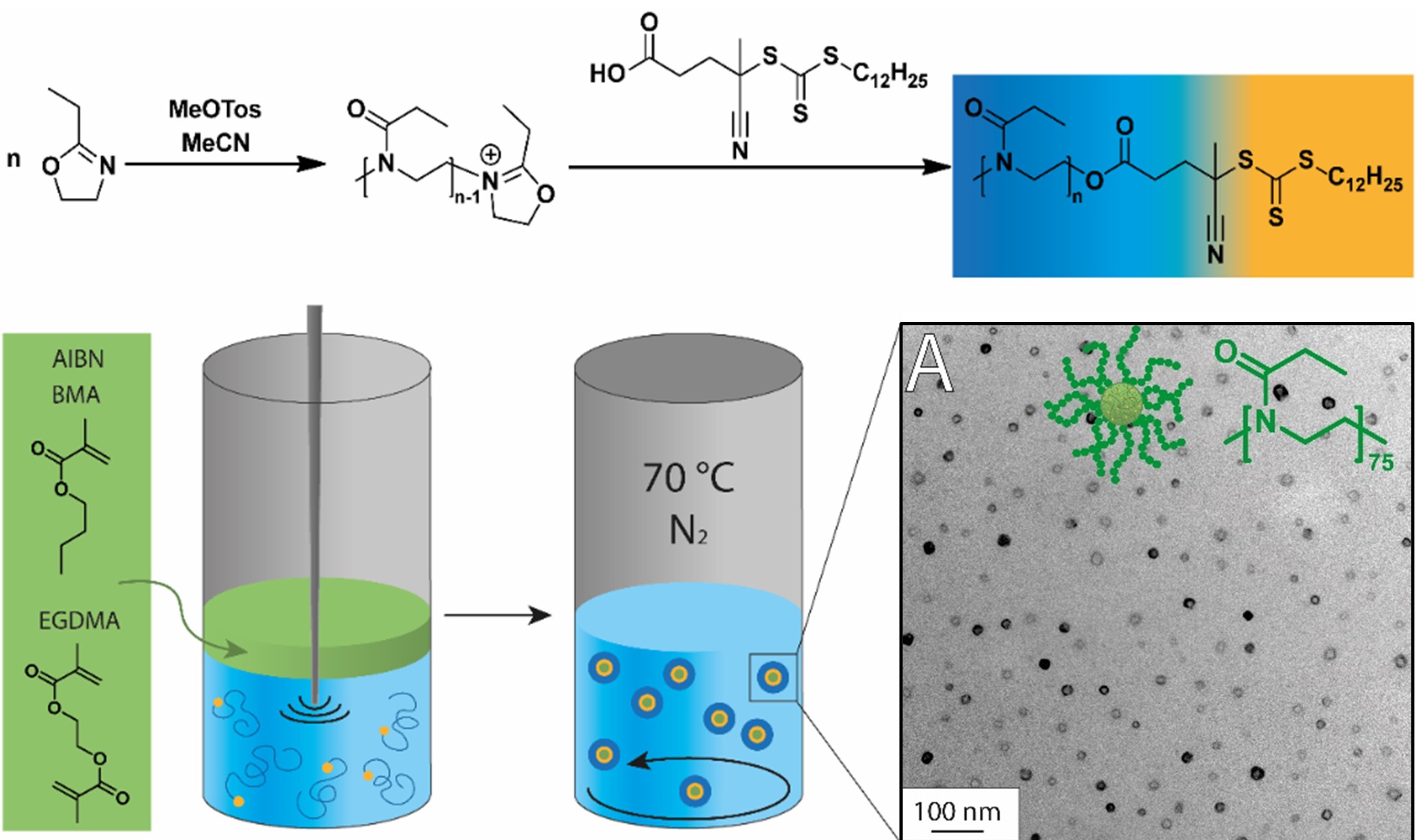Research
Research in the sustainable and functional polymers group is highly interdisciplinary. While the development and characterisation of novel materials plays a key role, the biological assessment is equally important.
The group is aimed to provide individual research topics of the interface between materials science and biology. Topics may focus on either site of this interface, providing individual projects on synthesis, characterisation or biological evaluation.
Amino-Acid-Derived Polyelectrolytes

We are working on the development of novel polyelectrolytes from sustainable, bio-derived resources, such as amino acids. With the aid of living and controlled polymerisation techniques (e.g., controlled radical polymerisation and living cationic polymerisation), we create tailored macromolecules with defined hydrophobicity and charge. To ensure valid conclusions about structure-property-relationships, extensive physicochemical of polymeric materials is a key research area.
M. N. Leiske* & K. Kempe* (2021) Macromol. Rapid Commun., 43 (2), 2100615: A Guideline for the Synthesis of Amino-Acid-Functionalized Monomers and Their Polymerizations
M. N. Leiske*, Z. A. I. Mazrad, A. Zelcak, K. Wahi, T. P. Davis, J. A. McCarroll, J. Holst, K. Kempe* (2022) Biomacromolecules, 23 (6), 2374: Zwitterionic Amino Acid-Derived Polyacrylates as Smart Materials Exhibiting Cellular Specificity and Therapeutic Activity
J. De Breuck, M. Streiber, M. Ringleb, D. Schröder, N. Herzog, U. S. Schubert, S. Zechel, A. Traeger, M. N. Leiske* (2024) ACS Polymers Au, 4 (3), 222: Amino-Acid-Derived Anionic Polyacrylamides with Tailored Hydrophobicity–Physicochemical Properties and Cellular Interactions
J. De Breuck, V. Jérôme, R. Freitag, M. N. Leiske* (2024) Macromol. Rapid Commun., 2400623: Zwitterionic Amino-Acid-Derived Polyacrylamides with a Betaine Twist - Synthesis and Characterization
Polymer Nanostructures

In the past, polymer nanostructures have proven promising for different applications (e.g., nanomedicine or as reactors for catalytic reactions). They allow to study structure-property relationships of polymeric materials in great detail. We are developing polymer nanostructures via non-covalent and covalent synthesis for different applications. We focus on smart synthetic approaches combining different polymerisation techniques (e.g., ionic and radical polymerisation) and post-polymerisation modifcations. The in-depth characterisation of polymer nanostructures is one of our key priorities.
M. N. Leiske* (2023) Eur. Polym. J. (185), 111832: Poly(2-oxazoline)-derived star-shaped polymers as potential materials for biomedical applications: A review
M. N. Leiske*. C. Kuenneth, J. De Breuck, B. G. De Geest, R. Hoogenboom* (2023) Macromol. Chem. Phys., 224 (24), 2300200: Amphiphilic Zwitterionic Bioderived Block Copolymers from Glutamic Acid and Cholesterol - Ability to Form Nanoparticles and Serve as Vectors for the Delivery of 6-Mercaptopurine
Poly(cyclic imino ether)s

Poly(cyclic imino ether)s such as poly(2-oxazoline)s are a versatile polymer class which posesses unique properties. The development of novel, functional monomers enables the precise tailoring of polymer properties. In our group, we are working on the design of poly(cyclic imino ether)s, with response to external stimuli such as temperature or pH-value. In addition we are constantly working on ways to combine the caionic-ring opening polymerisation of 2-cyclic imino ethers with other polymerisation technies - such as the reversible addition-fragmentation chain-transfer (RAFT) polymerisation - to create unique materials for potential applications in the life science area or as additives for sustainable plastics production.
M. N. Leiske, M. Lai, T. Amarasena, T. P. Davis, K. J. Thurecht, S. J. Kent,* K. Kempe* (2021) Biomaterials, 274, 120843: Interactions of core cross-linked poly(2-oxazoline) and poly(2-oxazine) micelles with immune cells in human blood
Site-Specific Polymers

One promising strategy to develop site-specific polymers is the incorporation of natural, low-fouling compounds, such as proteinogenic amino acids to yield amino-acid-derived zwitterionic polymers. Zwitterionic polymers have emerged as promising alternative to non-ionic stealth polymers as they can combine low fouling characteristics with tissue specificity. Many studies have observed accumulation in cancer cells and tumour tissue. Our research focusses on the development of amino-acid-derived zwitterionic polymers and their cell interactions to design polymers with high specificity to diseased cells.
M. N. Leiske*, Z. A. I. Mazrad, A. Zelcak, K. Wahi, T. P. Davis, J. A. McCarroll, J. Holst, K. Kempe* (2022) Biomacromolecules, 23 (6), 2374-2387. Zwitterionic Amino Acid-Derived Polyacrylates as Smart Materials Exhibiting Cellular Specificity and Therapeutic Activity
M. N. Leiske*, B. G. De Geest, R. Hoogenboom* (2023) Bioact. Mater., 24, 524: Impact of the polymer backbone chemistry on interactions of amino-acid-derived zwitterionic polymers with cells
M. N. Leiske*. C. Kuenneth, J. De Breuck, B. G. De Geest, R. Hoogenboom* (2023) Macromol. Chem. Phys., 224 (24), 2300200: Amphiphilic Zwitterionic Bioderived Block Copolymers from Glutamic Acid and Cholesterol - Ability to Form Nanoparticles and Serve as Vectors for the Delivery of 6-Mercaptopurine
